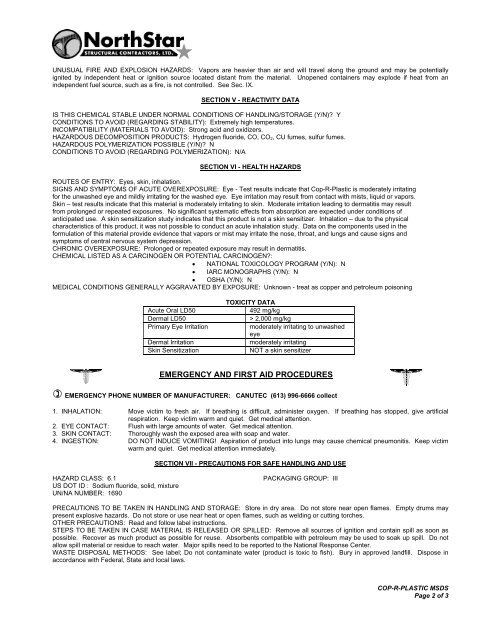Wood Preservatives Labels - BC Hydro
Wood Preservatives Labels - BC Hydro
Wood Preservatives Labels - BC Hydro
You also want an ePaper? Increase the reach of your titles
YUMPU automatically turns print PDFs into web optimized ePapers that Google loves.
UNUSUAL FIRE AND EXPLOSION HAZARDS: Vapors are heavier than air and will travel along the ground and may be potentially<br />
ignited by independent heat or ignition source located distant from the material. Unopened containers may explode if heat from an<br />
independent fuel source, such as a fire, is not controlled. See Sec. IX.<br />
SECTION V - REACTIVITY DATA<br />
IS THIS CHEMICAL STABLE UNDER NORMAL CONDITIONS OF HANDLING/STORAGE (Y/N)? Y<br />
CONDITIONS TO AVOID (REGARDING STABILITY): Extremely high temperatures.<br />
INCOMPATIBILITY (MATERIALS TO AVOID): Strong acid and oxidizers.<br />
HAZARDOUS DECOMPOSITION PRODUCTS: <strong>Hydro</strong>gen fluoride, CO, CO2, CU fumes, sulfur fumes.<br />
HAZARDOUS POLYMERIZATION POSSIBLE (Y/N)? N<br />
CONDITIONS TO AVOID (REGARDING POLYMERIZATION): N/A<br />
SECTION VI - HEALTH HAZARDS<br />
ROUTES OF ENTRY: Eyes, skin, inhalation.<br />
SIGNS AND SYMPTOMS OF ACUTE OVEREXPOSURE: Eye - Test results indicate that Cop-R-Plastic is moderately irritating<br />
for the unwashed eye and mildly irritating for the washed eye. Eye irritation may result from contact with mists, liquid or vapors.<br />
Skin – test results indicate that this material is moderately irritating to skin. Moderate irritation leading to dermatitis may result<br />
from prolonged or repeated exposures. No significant systematic effects from absorption are expected under conditions of<br />
anticipated use. A skin sensitization study indicates that this product is not a skin sensitizer. Inhalation – due to the physical<br />
characteristics of this product, it was not possible to conduct an acute inhalation study. Data on the components used in the<br />
formulation of this material provide evidence that vapors or mist may irritate the nose, throat, and lungs and cause signs and<br />
symptoms of central nervous system depression.<br />
CHRONIC OVEREXPOSURE: Prolonged or repeated exposure may result in dermatitis.<br />
CHEMICAL LISTED AS A CARCINOGEN OR POTENTIAL CARCINOGEN?:<br />
• NATIONAL TOXICOLOGY PROGRAM (Y/N): N<br />
• IARC MONOGRAPHS (Y/N): N<br />
• OSHA (Y/N): N<br />
MEDICAL CONDITIONS GENERALLY AGGRAVATED BY EXPOSURE: Unknown - treat as copper and petroleum poisoning<br />
TOXICITY DATA<br />
Acute Oral LD50 492 mg/kg<br />
Dermal LD50 > 2,000 mg/kg<br />
Primary Eye Irritation moderately irritating to unwashed<br />
eye<br />
Dermal Irritation moderately irritating<br />
Skin Sensitization NOT a skin sensitizer<br />
EMERGENCY AND FIRST AID PROCEDURES<br />
EMERGENCY PHONE NUMBER OF MANUFACTURER: CANUTEC (613) 996-6666 collect<br />
1. INHALATION: Move victim to fresh air. If breathing is difficult, administer oxygen. If breathing has stopped, give artificial<br />
respiration. Keep victim warm and quiet. Get medical attention.<br />
2. EYE CONTACT: Flush with large amounts of water. Get medical attention.<br />
3. SKIN CONTACT: Thoroughly wash the exposed area with soap and water.<br />
4. INGESTION: DO NOT INDUCE VOMITING! Aspiration of product into lungs may cause chemical pneumonitis. Keep victim<br />
warm and quiet. Get medical attention immediately.<br />
SECTION VII - PRECAUTIONS FOR SAFE HANDLING AND USE<br />
HAZARD CLASS: 6.1 PACKAGING GROUP: III<br />
US DOT ID : Sodium fluoride, solid, mixture<br />
UN/NA NUMBER: 1690<br />
PRECAUTIONS TO BE TAKEN IN HANDLING AND STORAGE: Store in dry area. Do not store near open flames. Empty drums may<br />
present explosive hazards. Do not store or use near heat or open flames, such as welding or cutting torches.<br />
OTHER PRECAUTIONS: Read and follow label instructions.<br />
STEPS TO BE TAKEN IN CASE MATERIAL IS RELEASED OR SPILLED: Remove all sources of ignition and contain spill as soon as<br />
possible. Recover as much product as possible for reuse. Absorbents compatible with petroleum may be used to soak up spill. Do not<br />
allow spill material or residue to reach water. Major spills need to be reported to the National Response Center.<br />
WASTE DISPOSAL METHODS: See label; Do not contaminate water (product is toxic to fish). Bury in approved landfill. Dispose in<br />
accordance with Federal, State and local laws.<br />
COP-R-PLASTIC MSDS<br />
Page 2 of 3
















